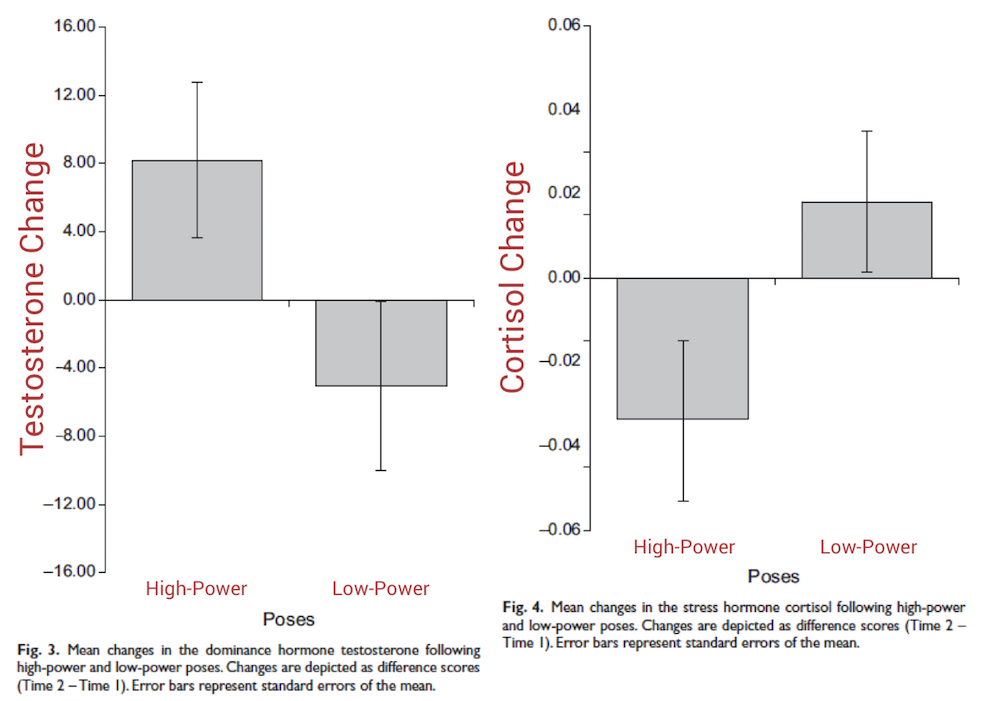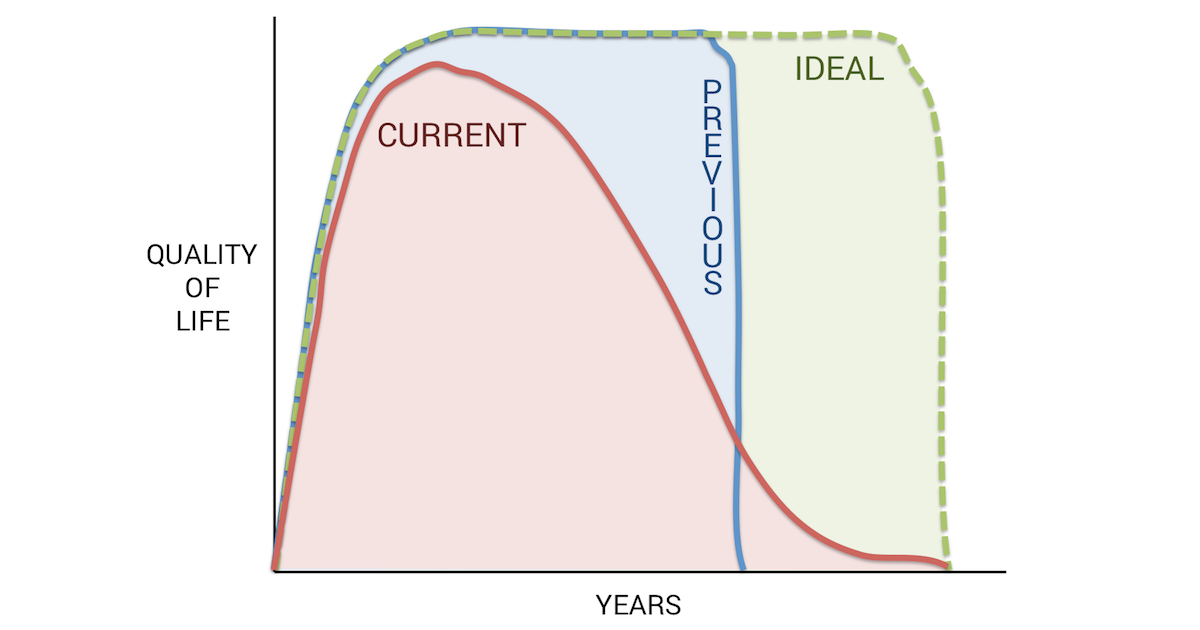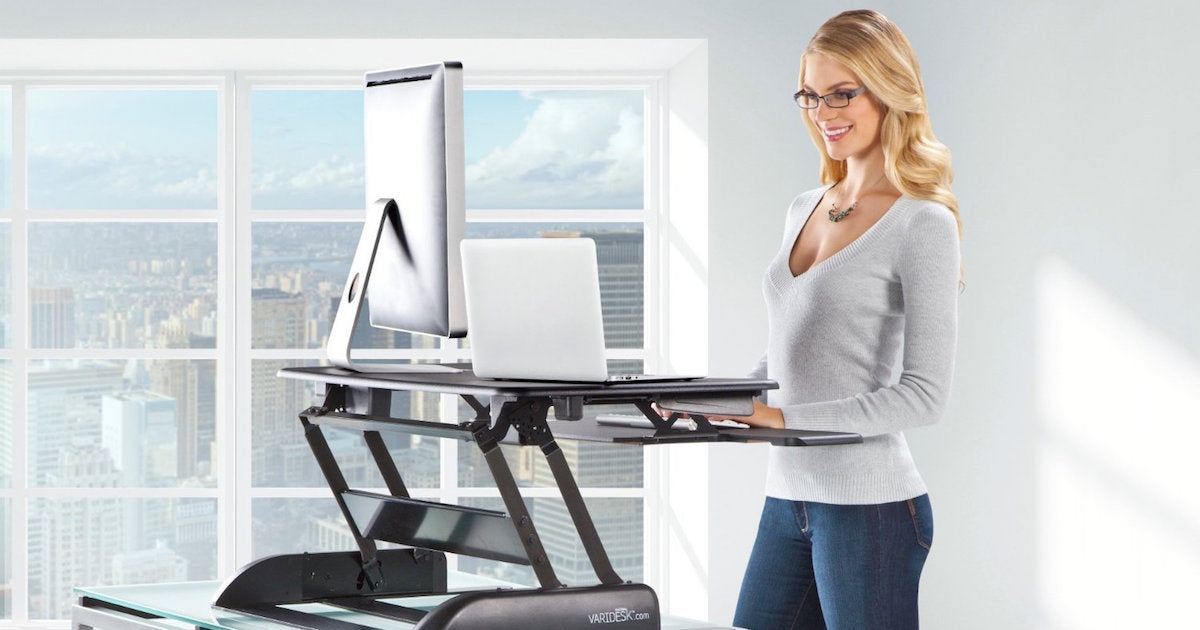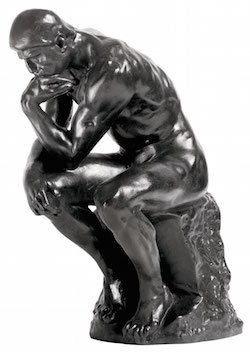
Sitting is best for contemplating Heaven and Hell.
“Sitting is the new smoking.” But did you know that sitting is actually better than standing for some tasks?
It’s true – and we’ve got the science to back it up.
We’ve been wanting to do a post like this for a long time. We’re going to dive deep into where standing beats sitting (and vice versa) for various cognitive tasks.
To help us out with this super science-heavy topic, we brought in Ryan Feeley, the chief technical officer over at Ergodriven. Ryan, the floor is yours.
*********
The nude male depicted in Rodin’s classic sculpture, “The Thinker” is sitting on a rock. Was this a mere random choice, or was the artist deliberate in using sitting to provoke the concept of thought?
It was almost certainly deliberate. Rodin’s statue was inspired by a scene of the poet Dante posed in front of the Gates of Hell, envisioning his great work the Divine Comedy, where he travels through the Inferno, Purgatorio, and Paradiso.
You know, just another day at the office.
It turns out, if you consider only the cognitive aspects, sitting may be the perfect position for Dante.
We’ll dig into the science of mental performance and body position further down, but if you want the short(er) version:
- Sitting maximizes short-term memory and allows for a high degree of detail in mental imagery.
- Provided you can stay on task, sitting shines for tasks with high short-term memory requirements that can be forgotten once complete.
- Great position for crafting compelling imagery or for debugging computer software.
- Good position for the mechanics of algebra.
- Standing is a position of action and execution.
- The increased full-body arousal supports higher levels of sustained information transfer between your brain and your work.
- There are a host of hormonal benefits that favor standing over sitting.
- The brain tends to see things a little more black and white.
- Great position for clear writing, reading comprehension, deadlines, email, and execution-heavy software development like refactoring and writing tests.
- Walking is a position of enlightened thought, insight, and possibly memory encoding.
- Can be good for daydreaming, thinking big thoughts and creative insight.
- Easy access to the power of walking is a key benefit of a standing desk. Just walk away for a moment. The effort of getting up from your chair might cause you to just sit and stew in frustration.
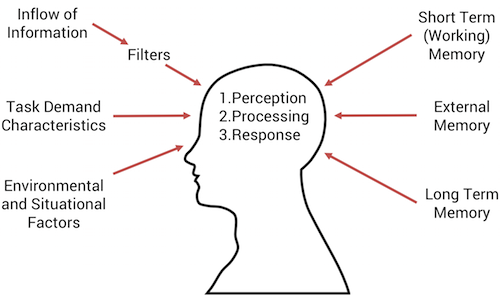
Can I be hacked?
Alert Equals Better, Right?
Not so fast. We’re all familiar with the concept of alertness and arousal. We’ve had our days of boundless energy, and our days of sluggishness.
What you probably didn’t know was that while a high level of arousal facilitates the detection and long term retention of information, it seems to inhibit immediate access to that information. Crazy, right?
Scientists have used stimulants, noise, light, hunger, and temperature to manipulate the arousal of test subjects and surprisingly they’ve found that higher arousal doesn’t always generate higher performance.
A leading explanation is the Resource Theory of Arousal, which was proposed by Humphreys and Revelle in 1980 to explain the dose-dependent impacts of caffeine.
This theory proposes that as a function of increasing arousal, more resources become available for sustained information transfer to and from your brain while fewer resources are available for short-term memory.
By combining these two aspects of cognition, the theory predicts that with increasing arousal, performance improves until the decrease in short-term memory is greater than the gain in information transfer.
Higher arousal means better information transfer to and from your work, but if you need short-term memory, relaxed is better.
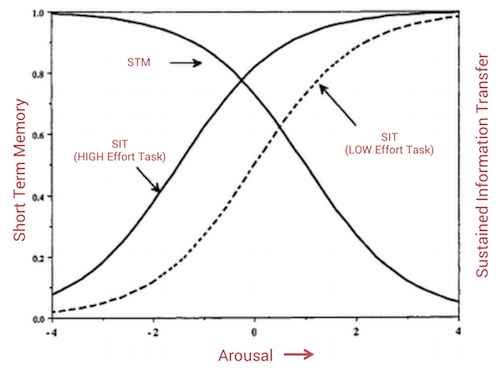
Higher arousal (like standing) means better information transfer to and from your work, but if you need short-term memory, relaxed is better.
Different tasks lean more or less heavily on either working memory or information transfer, so the optimal level of arousal depends on the nature of the task, however the data clearly suggest alertness and arousal have a short-term memory cost.
Work Performance and Arousal
So how does the resource theory carry over into real-world activities? Physiological arousal increases gradually during the day, and performance in most tasks shows a corresponding improvement.
Immediate memory, however, shows a significant decrease between morning and afternoon. It his seminal book “Attention and Effort”, Princeton Psychology Professor Daniel Kahneman concluded that available evidence suggests that:
-
A high state of arousal is associated with:
- Narrowing of attention.
- Fine discriminations are more difficult so things appear more black and white.
- Adoption of shortcuts and other systematic changes of strategy to complete tasks.
- Impairment of short-term memory, while long-term memory improves.
-
And a low state of arousal is associated with:
- A failure to adopt a task set at all — bouncing around without doing anything.
- Inaccuracies in self-evaluation leading to poor allocation of mental resources to the demands of the tasks.
This complicated schematic from Kahneman’s text summarizes how different degrees of arousal play into the process of generating responses to miscellaneous determinants (a.k.a., getting stuff done).
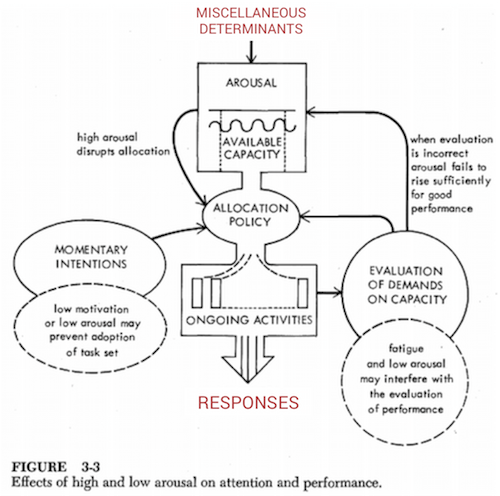
Using Science to Optimize your Posture for your Tasks
Let’s get down to practical advice here. What position should you be in for your day’s tasks?
Spending all day in a chair elongates and atrophies your prime mover muscles, and just leaves you a nonfunctional human being. None of us wants that. But frequently our job tasks are mentally taxing, and if we haven’t been staying on top of our nutrition, our energy levels may suffer as well.
Here are factors to consider for when you might want to sit, when you ought to be standing, and when it’s time to take a walk outside or recline in a daybed.
Sitting is for Working Memory
Sitting may wreck your running form, hurt your metabolism, and increase all-cause mortality, but it isn’t all bad.
As compared to walking on a treadmill, a 2009 study by exercise researchers at the university of Tennessee found sitting gave 6% to 11% better mousing, typing, and GRE exam level math problem solving, but was no better for selective attention and processing speed or reading comprehension.
Sitting obviously improves fine-motor control relative to walking, and the impact on math problem solving is completely consistent with the resource theory prediction that arousal cannibalizes short-term memory.
A more recent study from 2012 looked specifically at cognitive aspects of sitting versus standing, again, their conclusions were largely consistent with the resource theory.
A low-arousal position such as sitting gave the expected short-term memory boost (as measured by complex attention) while a more highly aroused condition such as standing provided a processing speed and information throughput advantage.

While statistical significance was not reached for all categories in this small study, the trend is higher psychomotor and processing speed when standing. [Click image to enlarge]
Furthermore, the standers in this study had horrible workstation ergonomics, and something as simple keyboard visibility and monitor distance, arguably rather important for unfamiliar computer-based tests, appear poorly controlled for. Your N=1 results may favor standing more than the study findings.
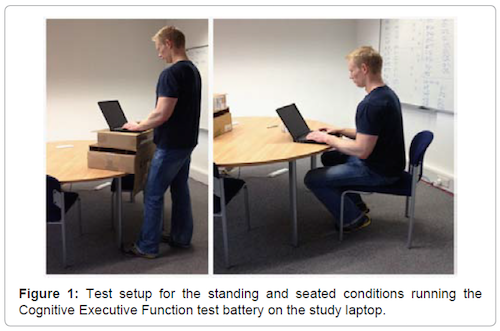
The ergonomics of this study looking at the impact of standing and sitting on cognition could have been a lot better.
You may find sitting and zoning out to be helpful in letting your mind wander, exploring creative options. Or even relaxing on a couch or daybed. Or you may find this just makes you sleepy and prefer to take a walk. So do some self-experimentation to dial in your creativity, and don’t be afraid to try both.
Standing is for Focus and Execution
When Herman Miller, currently known for expensive chairs, introduced the Action Office Standing Desk in 1958, the designer Bob Propst wrote:
“Compelled by lack of choice, we are forced to conduct most office activity in a sitting position. The result, as medical studies and insurance data make clear, is a steady decline in vitality, energy, and general body tone. Man’s physical machine has evolved to do many things well but no single thing continuously.”
Several firebrands from history are famous for working at standing desks, including Leonardo da Vinci, Thomas Jefferson, Friedrich Nietzsche, and Winston Churchill. You can bet that each of these figures benefited from the vitality, energy, and focus provided by standing.
Sitting with low arousal ups the risk for momentary distractions and being “off-task” and also contributes to both an under-estimation of required effort (e.g., over-promising) and an over-estimation of current performance.
Of course, overly high arousal can result in excessive decisiveness, a tendency to see everything in black and white, and increased adoption of “shortcuts” as a means of strategy, which can increase error rates (see, e.g., another famous stander, Donald Rumsfeld). Standing, when not fatigued, hits a sweet spot for many execution-based tasks.
Standing Encourages Variety
This aspect of standing wasn’t addressed by any study that we could find, but there are countless testimonials to that fact that it is real, and perhaps the biggest performance-enhancer of a standing desk. One description we particularly like is from Jeremy Bushnell, author of “The Weirdness“:
The thing that separates successful people from unsuccessful ones, more than anything else, is persistence.
Everyone encounters obstacles in their work, but the persistent overcome. How? The easiest trick is to cultivate a productive habit for when you get stuck.
If you are sitting in front of a computer, Facebook is a click away. But if you are standing, two steps to the left, pirouette, and … breakthrough! If that didn’t work, you must be right-handed, but I think you get my drift.
Both sitting and walking on a treadmill tend to be “sticky” activities. Their inherent inertia requires effort to switch to another movement pattern. Standing is liberating.
Big Hormonal Benefits from Standing
The hormonal impacts of expansive postures are known to the over 22 million viewers of Harvard professor Amy Cuddy’s famous Ted talk on body language and power poses. In their paper in the journal Psychology Science, Cuddy and her colleagues from Columbia showed that the neuroendocrine profiles of the two key hormones that differentiate the powerful from the powerless, testosterone and cortisol, can actually be manipulated by choosing expansive positions with open limbs instead of contractive positions with closed limbs.
Standing FTW!
For you male readers, standing also better supports the naturally lower temperature of the testosterone factories between your legs.
Standing Impacts Melatonin Too
And for you night owls, both sitting and standing after midnight increases melatonin levels relative to lying down.
Melatonin is naturally low during the day and high at night as it guides your body into the nocturnal sleep phase.
If you aren’t lying down when night falls, your body notices that you are in no position to sleep and fights back with higher melatonin until it gets what it wants.
Just last year, researchers in Japan showed that standing late at night causes significantly higher free melatonin in the blood when compared with sitting. So standing at night may make you sleepier faster.
Good news if you are one of the millions of people who struggle with insomnia, but not so great if you are up late cranking on an urgent project.
Consider Limiting Standing during Memory-Heavy Tasks
Beyond the arousal, task execution, and hormonal benefits, the cognitive situation for working while standing is mixed.
Sitting has been shown to have advantages over standing in certain cognitive tests that rely heavily on working memory, and sitting gave significantly better mathematical problem solving (~11%) than treadmill walking in the Tennessee study we cited previously.
However, standing gave 10% higher math performance over sitting in another recent work out of the Philippines that studied engineering students, who presumably excelled at mathematics. This study directly compared standing and sitting during 2-hour and 4-hour duration college-level examinations and found this big effect for math but no effect for reading.
The authors hypothesized that the stressful nature of a college exam may be better managed by a standing student who has greater space and opportunity for movement and postural self-determination, and further that standing might provide a benefit through higher sustained alertness over the duration of the multi-hour tests.
The paper does not provide a full description of the test conditions, but we suspect that the sitting students under pressure of an examination rarely left their chairs, which may have negatively impacted their scores through higher discomfort.
Walking is for Insight and May Enhance Learning
Aristotle, the great student of Plato and personal tutor to Alexander the Great, preferred to lecture his students while taking a walk. Various monks and thinkers throughout history had a daily practice of simultaneous promenading (that’s fancy-speak for walking) and reciting of passages.
In fact, the ancient Greek word theoria—from which the word theory stems—originally signified a ritual journey, in particular a pilgrimage undertaken to witness an event or visit the sacred dwelling of a god.
Last time we checked, most gods frown on visits from sitters.
Friedrich Nietzsche certainly thought so. Upon hearing that the habitually sedentary author of Mademe Bovary, Gustave Flaubert, claimed to his protégé
“One cannot think and write except when seated.”
Nietzsche lashed out with his usual vigor:
“There I have caught you, nihilist! The sedentary life [das sitzfleisch—literally ‘sitting meat’] is the very sin against the Holy Spirit. Only thoughts reached by walking have value.”
Wisdom of the ancients aside, modern science has unearthed a lot of compelling arguments for shunning the sedentary life for thoughts reached by walking. We’ve highlighted the benefit it can have for breakout insight when you get stuck on a thorny problem. Moderate physical activity improves various cognitive functions, and in some cases there is particular benefit to simultaneous exercise and cognitive execution.
This past year, a research team from Germany concluded that during low intensity activity (< 50% VO2 max), treadmill walking improves long-term vocabulary memorization. The researchers proposed that the temporal predictability of a treadmill focuses attention on anticipated points in time, which results in a more efficient allocation of cognitive resources.
This effect wasn’t true for all study participants, so your mileage may vary, but do try it out if you currently spend time on a treadmill.
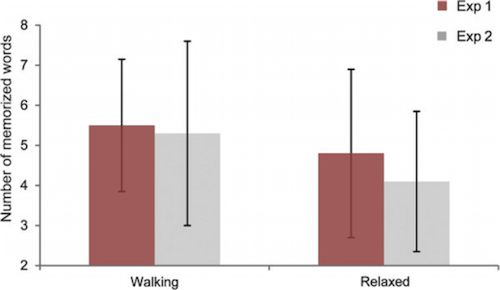
Both experiments showed walking adds ~20% more memorized foreign language vocabulary words than relaxed sitting!
Take Home
We hope you learned a few new tricks to hack your personal performance.
Given the above, here’s how I’d break up my day by task:
- Stand up for execution focused tasks, like answering email and most forms of writing.
- Sit down for tasks that require high concentration, like advanced calculus, and aim to do these in the morning, when memory tends to be better.
- Walk for highly verbal tasks (preferably not on a treadmill), like phone calls.
- When in doubt – my default position is standing. The health benefits likely outweigh any performance drawbacks if they aren’t so obvious that I notice them.
Even if you don’t currently have a standing desk, you can gain an edge by building more walking into your day and cultivating a productive habit for when you get stuck on something.
If you do have a standing desk, but feel like you “really want to sit” for a task that requires high levels of concentration, go ahead, the science is on your side. Just don’t make a habit of it.
The dose makes the poison so don’t let sitting pollute your get-stuff-done attitude, hormonal profile, and functional biomechanics.
The post When Your Standing Desk Might Actually Hurt Your Performance appeared first on Quitting Sitting.


